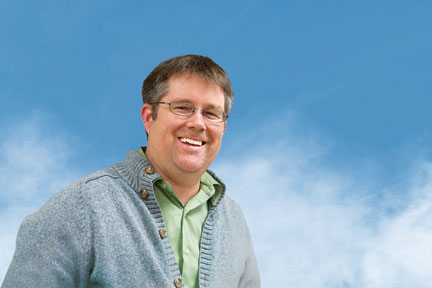A breakthrough in the clouds?
The key to more accurate climate change predictions might be hiding 11 miles up.

Physics Professor Nathan Magee is unraveling scientific puzzles about cirrus clouds. Photo (c) Lynne Delade.

Nathan Magee is no stranger to bad weather. The associate professor of physics hails from Chardon, Ohio, a town famous for being one of the snowiest in the country. Locked within Lake Erie’s snowbelt, Chardon receives more than 100 inches of snow per year.
But the snow itself didn’t bug Magee as much as the erratic predictions of local weathermen who were “notoriously bad at predicting lake-effect snow,” he recalls. “Growing up, I made it one of my projects to forecast better than the meteorologists on TV.”
As the first recipient of the Gitenstein-Hart Sabbatical Prize, Magee has the opportunity to work toward that goal. Created through a $100,000 gift from President R. Barbara Gitenstein and her husband, Dr. Donald B. Hart, the endowment supports an annual full-year sabbatical that allows faculty members to further their scholarship outside the classroom. Magee will spend the coming academic year working in experimental cloud physics, unraveling scientific mysteries that could help improve climate change projections.
One of the puzzles he is trying to piece together involves cirrus clouds—high-altitude clouds that streak across the sky like delicate wisps of white hair. “They are the thinnest, highest clouds that are made of ice crystals,” he says. Current numerical models are notoriously bad at predicting their behavior—there shouldn’t be as many in the sky, and they should be more fleeting—but no one knows why. This disparity between theory and reality is a large source of uncertainty in atmospheric scientists’ understanding of climate change.
But Magee, who directs the experimental cloud physics lab at TCNJ, discovered something in 2012 that might give a hint as to why the models are lacking: ice crystals aren’t smooth. Using the highest resolution anyone has ever seen, Magee recorded images using a powerful environmental scanning electron microscope. Those images showed that “there are ridges, steps and valleys on the surface of an ice crystal that you can’t see with a light microscope,” he said. “We were surprised.”
Because light hits a mirror-like surface much differently than an uneven one, Magee believes this could be a large source of error in cirrus cloud calculations. He has studied only lab-grown ice so far, but as part of his sabbatical research he plans to send a weather balloon up to 60,000 feet to capture samples from an actual cirrus cloud.
“We’ll be applying new nanotechnology tools to answer fundamental questions about the way these ice crystals behave in the atmosphere, and in turn how they impact climate—questions that weren’t accessible before recent technological innovations,” he said.
Posted on May 27, 2014

